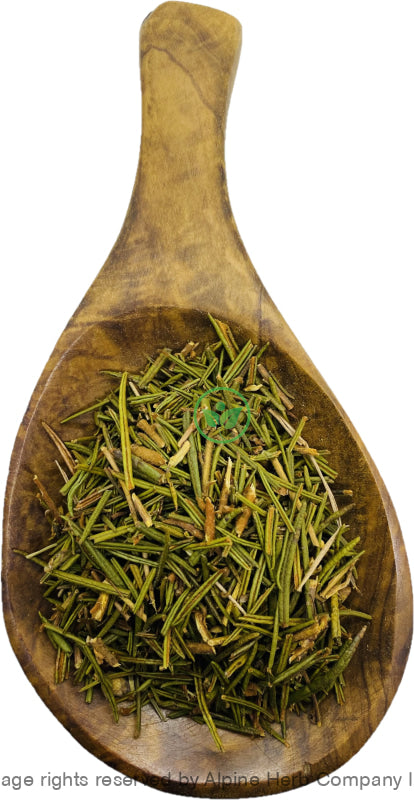Marsh Labrador Tea Cut Alpine Herb Company Inc.
$ 20,49 $ 12,29
Botanical Name: Ledum palustre
Common Name:
- English: Labradoe Tea, Labrador Tea
- Also, known as: Marsh tea, Marsh Labrador tea, Northern Labrador tea, Wild Rosemary, and Marsh rosemary, James’ Tea, Lède des Marais, Ledi Palustris Herba, Lédon des Marais, Ledum palustre, Ledum Silvestre, Marsh Citrus, Moth Herb, Northern Labrador Tea, Petit Thé du Labrador, Rhododendron palustre, Rhododendron tomentosum var. tomentosum, Romarin Sauvage, Romero Silvestre, Sumpfporst, Swamp Tea, Te de Los Pantanos, Wild Rosemary
Origin: Ukraine
Harvested: Wild or Cultivated
Parts Used: Leaves
General Information:
Ledum palustre, is a low evergreen shrub growing to 50-60 cm in height. Interestingly, this shrub can generally survive fire as the rhizomes are found deep in the organic layer and it is often found in areas too wet to burn. Labrador tea is technically a flowering shrub with many erect branches, white flowers and distinctive evergreen leaves. It is one of the first plants to re-colonize after fire and grows rapidly. Leaves grow alternate, simple, evergreen, fragrant when crushed, and have a short-petiolate. Leaves are 10-40 mm long and 2-10 mm wide. They have a leathery-texture, are dull and dark green above, with the lower leaf surface densely covered in matted woolly hairs that turn from white to rusty-brown at maturity. The flowers are small, with a five-lobed white corolla, and produced several together in a corymb 3-5 cm in diameter. Numerous white flowers occur in showy rounded umbel-like terminal inflorescences. The flowers are hermaphrodite, have both male and female organs, one cm across; the calyx is small and five toothed; the corolla is composed of five white ovate to oblong petals, fused at the base. They emit strong smell to attract bees and other pollinating insects.
Walking through the flowering brush is an experience, not just for the abundant display of flowers but also for the heady aroma. Labrador tea’s aroma comes from essential oils such as ledol, palustrol and myrcene. These compounds repel cattle and large mammals, and can give sensitive people a headache. Despite its toxicity it has been cleverly used to flavor beer, instead of or alongside hops. The leaves are hung up in the clothes cupboard to repel insects. The branches are also placed among grain to keep mice away. A strong decoction of the leaves is used to kill lice and insects. The leaves contain tannin.
The plant is more strongly narcotic than Ledum latifolium and should not be used without expert supervision.
How to use:
Hot Infusion:
The basic method for dried herbs and flower is, take 2-3 tablespoons of dried herb in a cup or teapot. Pour hot water over it and cover it with lid for 10-30 minutes. Hot water is needed to draw out the antioxidants, enzymes, vitamins, flavonoids, and volatile oils from the botanicals. Strain and squeeze out as much as liquid as possible and enjoy!
Tips:
- You can sweeten your herbal tea with a bit of honey, natural fruit juice, stevia leaves powder and or licorice root powder.
- You can make ice cubes or pops by freezing tea in ice trays or pop molds.
Precautions:
You should consult with a qualified healthcare practitioner before using any herbal products, particularly if you are pregnant, nursing, or on any medications.
All information on this website is for educational purposes ONLY.
This information has not been evaluated by Health Canada.
This information is not intended to diagnose, treat, cure, or prevent any disease.
| Unit Size | 100g, 200g, 400g, 1kg |
|---|
Prompt shipping and expert packing
Thanks to our longstanding association with UPS FedEx DHL as well as other leading global carriers, we can offer a variety shipping options. Our warehouse staff is highly trained and will be able to pack your goods in accordance with our precise and exact specifications. Your items will go through an exhaustive examination before they will be securely packaged before being delivered. We ship to hundreds of thousands of customers daily in different countries. This is a sign of our determination to become the largest online retailer worldwide. Warehouses and distribution centers are located throughout Europe as well as in the USA.
Note that orders containing multiple items are processed according to the particular item.
We will thoroughly inspect all items ordered before shipping. Most orders are shipped within 48 hours. The delivery time will be between 3 and 7 working days.
Returns
The stock market is always changing. It's not entirely managed by us since we're involved with several entities, including the factory and the storage. Therefore, the actual inventory could fluctuate at any moment. Please be aware that it is possible that your order could be out of stock after you've placed your order.
Our policy lasts for 30 days. If it's been more than 30 days since the date you purchased your item We're sorry to say that we can't offer you a full exchange or refund.
You can only return a product if it is unused and still in the same state as when you received it. The item should be in the original packaging.


































